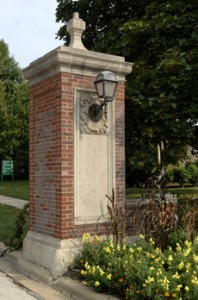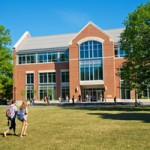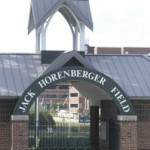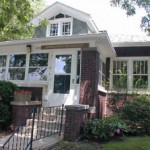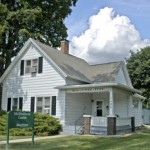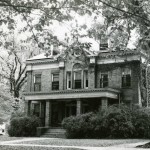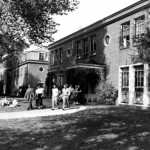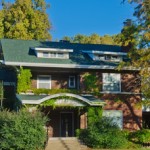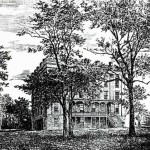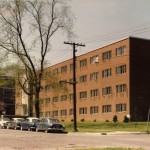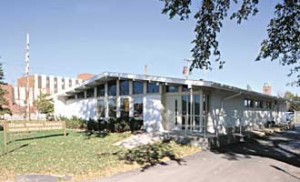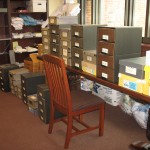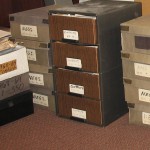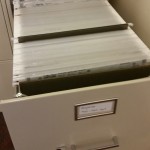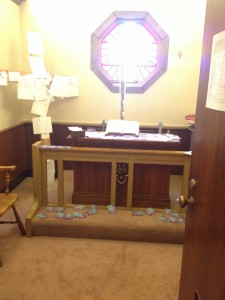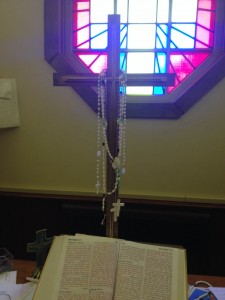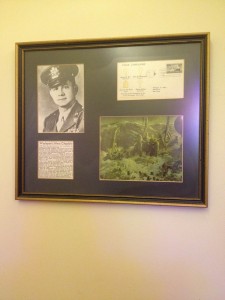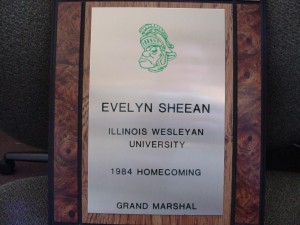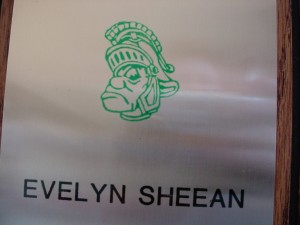Munsell was born in Ohio in 1825. He graduated from Indiana Asbury University and then later studied law and was admitted to the bar. He served as the principal at two different seminaries and was the president of Illinois Wesleyan University from 1857 – 1873.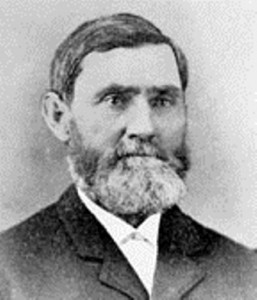
Category Archives: Research files
Presidential Biography: Clinton W. Sears
Sears was the first official president of Illinois Wesleyan University and served from 1855 until 1857. He was born in New York in 1820 but spent most of his life in Ohio. He graduated from Wesleyan University in Connecticut in 1841. Before his presidency, he held the dual position of librarian and Professor of Ancient Languages and Literature.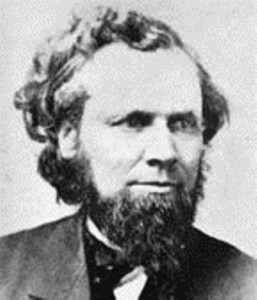
According to the 1998-99 President’s Report*, one notable contribution Sears made was ensuring there was a “‘substantial sidewalk’ linking the school and town. Sears noted that when it rained, the roads became so muddy it was impossible to get into town from the school ‘out in the country.’ In fact, he was so determined to connect Illinois Wesleyan with the growing community of Bloomington that he spent $500 of his own money to build the sidewalk.”
*Quoted from “Part 1-The Beginning,” One Building, One Sidewalk: 1850-2000, Past is Prologue. 1998-99 President’s Report, A Sesquicentennial Preview (p. 5). University Archives Record Group 5-2/7.
Research Files: IWU’s First International Students
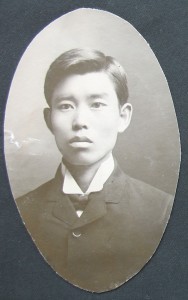
Photo scanned from a scrapbook held in IWU archives. The person is unidentified but the book includes named graduates from classes in the years after 1890.
In 1890, Wesleyan’s first two international students graduated from IWU’s Law School. Their names were Yeizo Osawa and Kashiyira Tanaka. They were from Tokyo, Japan, and were in residence on campus when they graduated. Stories in our student publications relate how they shared their culture with IWU’s campus, such as delivering lectures and describing some of the customs of Japan. Their presence among the graduation class of 1890 was even noted in local newspapers and in the Chicago Tribune.
Even earlier, other graduates with international addresses received degrees through our Non-residential program, meaning they did not have to attend classes on our campus. This program is described the following way in an 1895 publication:
The object of this step was to furnish lines of systematic study for those professional men and women whose duties and environments are such as to make a resident course of study an impossibility, and yet who earnestly desire systematic study.
Sounds a lot like what online learning programs promise today, doesn’t it?
An early graduate of the program with an international address is Rev. John Oakly Spencer of Japan, who graduated with a Ph.B in 1888. One wonders about the possibility of Osawa and Tanaka meeting Oakly and finding out about our small school in Central Illinois!
Other Non-resident graduates living abroad in the same time period were Rev. Myron Chesterfield Wilcox of China who also graduated with a Ph.B in 1886, and William Groves of Uruguay who graduated with an M.A. in 1897. William C. Armstrong and Frederick W. A.Meyer, of Ontario, Canada and Arthur Thomas Carr of Birmingham England all received M.A. in 1896.
These men were not international students in the same way we think of today, but they demonstrate our current philosophy has long-standing roots: bring the world to Wesleyan and Wesleyan to the world!
To learn more you can visit Tate Archives and Special Collections in the Ames Library or contact us at archives@iwu.edu!
Research Files: IWU’s First Black Students
Guest posted by Melissa Mariotti, edited by Meg Miner
One recurring question asked in the archives is when did IWU admit students of color? While Illinois Wesleyan may not have been the first school to have a graduate of color, it did admit students of color not too long after its opening in 1850 but not without some prompting.
We lack easily accessible information on demographics for early students, but the earliest evidence comes from an argument that played out in a local newspaper surrounding the admission of “a colored boy” to IWU’s Model School (aka, elementary) program. The anonymous letter writer stated that the student’s “request was refused” (The Daily Pantagraph, May 9, 1867, p. 4). The writer makes the pointed criticism that the student was qualified by published standards for admission at the time and questions why a specific vote was needed. His conclusion is that it was due to the color of his skin.
Archives Record Group 16-1/10 contains a research file compiled about Black History at IWU, including photo copies of these local news sources, that show a series of commentaries by the writer calling himself “Radical” and one response from then-President O.S. Munsell.
We can use the date in these sources for further exploration of the question.
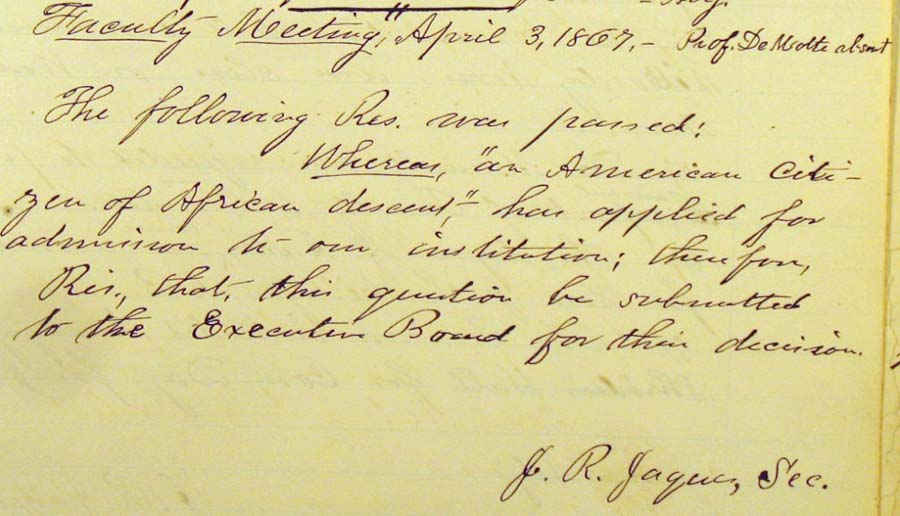
An 1867 faculty resolution on the request of “An American citizen of African descent.” [click to enlarge]
There is no detailed discussion in any known IWU source about the case, but the culmination of this early effort seems to have finally occurred 13 years later.
Gus A. Hill is the first known African American student to attend Illinois Wesleyan University. He was a member of IWU’s Law School, Class of 1880. He was mentioned several times in our student newspaper of the era, which was known as the Wesleyan Bee. For instance, in the February 1st, 1883 Wesleyan Bee, the article refers to him as “a colored man and brother.” We have no photographs of Hill in the archives or campus publications.
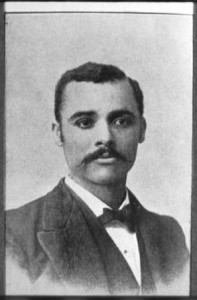
“Alfred O. Coffin, an early African-American graduate of the University, was born to slave parents and went on to become a teacher and college professor.” — Continuity and Change, 1850-2000 by Minor Myers, jr. and Carl Teichman.
In 1889, Alfred O. Coffin became the first African-American in the U.S. to earn a Ph.D in Biology. Editors of another student paper titled the Elite Journal, also refer to Coffin as the “talented young colored gentleman” in the April 19th, 1889. Coffin lived in Texas and was enrolled in our version of a distance-education program, so having his presence on campus noted while he was on campus for his final exams indicates contemporary students’ interest in his story. Anyone interested can visit the University Archives to see book one of a two-volume “herbarium” set that Coffin created for his degree completion requirements.
That book was discovered just two years ago in a campus office. Book two wasn’t with it but it offers me a chance to remind everyone that while IWU is 165 years old, it is still possible to make unexpected finds, so keep your eyes open whenever the spring cleaning bug strikes!
N.B. The first known record of international students enrolling is in 1889 and will be described in the next post. Another “first” was women’s admittance to IWU in 1870, although a discussion about that possibility is first recorded in 1851. Two brief presentations on this topic — one in 2010 and one in 2014 — are available for introductions to that part of our history.
To learn more about this topic, or just to visit and marvel at 126 year old plants from A. O. Coffin’s Texas collection, visit Tate Archives and Special Collections in the Ames Library or contact us at archives@iwu.edu!
Research Files: The Founders’ Gate/West Gate
Guest posted by Melissa Mariotti
As most students and faculty know, there are several main entrances into Wesleyan’s campuses. There is the North entrance on Franklin Avenue, the South entrance by Empire Street, the East entrance by Park Street, and the West entrance by Main Street. There is not much known about the latter entrance. It stands between Pfieffer and Gulick Halls and bears the inscription:
“We stand in a position of incalculable responsibility to the great wave of population overspreading the valley of the Mississippi. Destiny seems to point out this valley as the depository of great heart of the Nation. From this center mighty pulsations, for good or evil, must in future flow, which shall not only affect the fortunes of the Republic but reach in their influence other and distant Nations of the earth.”

The West Gates, looking north toward the Women’s Dormitory. From a 1931 booklet of pen sketches of Illinois Wesleyan University; RG 4-16/2/4.
Upon further research, it was discovered that the gates were ”erected and presented to the school by the Bloomington Association of Commerce in 1921” (Founders’ Day Convocation, 1999). There are two differing theories about where this quote came from. According to the 1960 Wesleyana, it is “an excerpt from the report on education to the annual meeting of the Illinois Conference held in Springfield in 1854.” But according to an Argus article from February 13th, 1940, it was said on December 18th, 1850 from the “Conference Record.”
The quote (see image below) was verified in the Methodist Conference Record of 1854 by the archives that holds the Conference Record for 1854: The Illinois Great Rivers Conference Archives at MacMurray College, Jacksonville, Illinois. There is more to the quote than was summarized on our West Gates, but the spirit of the passage resonates just as much today as it did for our Founders.
The quote that is inscribed on the gate is said to represent “the ‘incalculable responsibility’ the founders of Illinois Wesleyan felt in the work they had undertaken” in establishing Illinois Wesleyan as an “institution of learning” (President Wilson, Founder’s Day Convocation Remarks, 2006). It describes the passion that the Founders had for teaching and learning, along with the many obstacles they had to face into creating the school. This inscription is referenced many times during Founders’ Day Convocations, and is evident in the care and consideration of all who work to sustain and advance that goal today.
The text is as follows: “The Methodist Church, in the West and Southwest, stands in a position of incalculable responsibility to the great wave of population overspreading the valley of the Mississippi. Destiny seems to point out this valley as the depository of the great heart of the nation. From this center mighty pulsations, for good or evil, must in future flow, which shall not only affect the fortunes of the republic, but reach in their influence, other and distant nations of the earth. The advances herein reported which are being made by the Methodists on the subject of education in the bounds of the Illinois Conference, flatter the idea that, in so far as our section of the church is concerned and especially the division of it embraced in the Illinois Conference, cheering success will attend our future efforts to contribute our share towards the general education of the great masses. In addition to all other motives conspiring to lead us forward in this noble work, patriotism or the love of country is not the least. The nature of our constitutions and laws demands it. The tenure and price of our liberties are involved in it. The sovereignty invested in the whole people imperiously requires it; and recent events, as they have been connected with the civil questions which have agitated the nation, some of which questions have sprung from the tide of foreign emigration setting in upon American soil, call loudly for the work of education to go forward-the education of nothing less than the whole American mind; an education, too, that shall be American in all its essential principles.”
Research files: Acquisition/construction dates
Guest posted by Melissa Mariotti
As students and faculty, we are constantly on the move across campus, but while walking have you ever wondered about all the different buildings that are around us? Though Illinois Wesleyan is not a large campus, the number of buildings and their individual histories make up for its small size. The dates of acquisition and construction of each building range over time, creating a blend of older and newer buildings on campus.
The most recent building, State Farm Hall, was finished in 2013 and replaced the Sheean library, constructed in 1968. Before the Sheean and State Farm Hall, the first building on IWU’s campus, Old North Hall, was built to the east, in roughly the same area as the current sidewalk leading to CLA, and lasted from 1856 until 1966.
- Quad Duration Hall. Approximate date 1964 or ’65 due to presence of Old North on right and Sheean not yet started.18-1/17 Aerial Photographs
- Sheean Library 1970s, found in RG 18-1/17/Sheean Library
- State Farm Hall exterior views, found on IWU website
The Alumni Relations Office was created in 1991 on January 15th alongside the later dedication of well-used Baseball Field in honor of Jack Horenberger on April 11, 1999. Only a year later, on April 14, 2000 the Softball Field also held its inauguration when the Titans hosted North Park.
- Softball Field, found at iwusports.com
- Jack Horenberger Field, Found on IWU website
Dialing the clock only a little farther back, the records of the Physical Plant also reveal the creation of buildings such as Publications, Printing, and Mailing Services on January 3, 1996; Information Technology on August 4, 1983; and the well-known Multicultural Center on November 20, 1980.
- IT House, found on IWU Website
- Multiculturalism Center, found on IWU Website
Some of the more common and well-loved buildings of campus also have long histories. The E. Melba Johnson Kirkpatrick Laboratory, or better known by theatre goers as the Lab Theatre, is actually part of the Alice Millar Center for Fine Arts which received its dedication on March 18, 1973. It was not until the autumn of 1993 that the Lab Theatre received its name in dedication. The Memorial Center has been home to many offices, rooms, and places of events. For instance, the Bertholf Commons, the campus’s largest dining hall, can be found there. The commons was dedicated to President Bertholf, who held office between the years of 1958 and 1968. Even the International Office, which is currently located in the Center for Liberal Arts (CLA), used to be housed in the Memorial Center. Some of the oldest buildings on campus are some of the least known. The English House was built in 1911, but was not acquired by Wesleyan until 1947. The Security office that we know today was a coach house for what is now called Blackstock Hall (acquired in 1937). The coach house has also been an art studio and the English House was once the Gallery Building. Look through the changes to our campus at the collection of historical maps online at http://collections.carli.illinois.edu/u?/iwu_histph,1185.
- Blackstock Hall, found in RG 18-1/17/Blackstock Hall
- Memorial Center
- English House. Found on the IWU website.
For many of the students on campus, after a day of classes, work study jobs, extracurricular activities, and studying, we all enjoy being able to return to our various residence halls for a bit of relaxation and rest, not to mention a place to live during the school year. The first residence hall was built in 1878 and was known as Henrietta Hall, a residence hall for women only. It was run by a group expressly created for that purpose: the Women’s Education Association of IWU. It was also originally known as the Young Ladies’ Boarding Hall. The second residence hall was Kemp Hall. It was formerly known as the DeMange Mansion and was renamed in honor of President Kemp after it was acquired in 1912 and was also an all-women residence hall. Until 1987, it also was home to a dining hall and offices for faculty members. Dolan Hall – formerly Franklin Hall for Men – was built in 1955 and was one of the first dormitories established for men. Prior to this time, men either lived in fraternities or resided off campus. A new Women’s Residence Hall is opened on the corner of East and University Streets in October of 1956. We know it today as Anna Gulick Hall. At the time of opening, it was also home to “The Sarepta Bane Whipp Department of Home Economics.” See front page story in the 1956 IWU Bulletin.
- Sketch of Henrietta Hall Found in RG 18-1/17/Henrietta Halll
- Dolan Hall (Franklin Hall) 1956 Found in RG 18-1/17/Dolan Hall
- Gulick Hall (1956) Found in RG 18-1/17/Gulick Hall
Until 1998, IWU’s Publications, Printing, and Mailing services resided in Holmes Hall. It was decided that the space was too small for the services and was moved to its current location, a small building off of Franklin Avenue nearby the TKE fraternity house. Before that, the building was actually a dentist’s office until it was acquired by Wesleyan at an unknown date. The space was vacant for sometime, and it was supposedly meant to be used as a child care facility. See the full article in the February 6,1998 IWU Argus.
Architectural history is alive and well on our campus, but this is only a short list of the buildings that cover the grounds. You will find photographs of these and other IWU landmarks in our online collection.
To learn more about other buildings new or old you can also visit Tate Archives and Special Collections in the Ames Library, or contact the Archives at archives@iwu.edu!
Research Files: ISU’s Victory Bell
Gallery
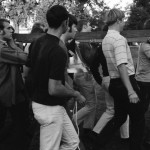
This gallery contains 4 photos.
Guest posted by Melissa Mariotti Up until the fall of 1969, the IWU football team played an annual game against the team from ISU. In addition to this tradition, each school had their own victory bell that would be rung before … Continue reading
Photo project complete!
In 2011 the archives acquired a group of photographic material from the Office of Communications. Since then a succession* of diligent archives student assistants have worked steadily to place the contact sheets and negatives together in high quality sleeves, transfer information from the old filing sleeves, and then to store them in hanging file drawers for ease of access. Actually, many people** at IWU deserve the thanks of all future IWU photo seekers.
Below are a few then-and-now pictures to give a sense of this effort. The years spanned in these image files are 1966-2002, though the bulk of the negatives are from 1970s-1990s. A rough estimate of the total comes to about 40,000 images. Some information is searchable in a database (available in the archives) created by a couple of generations of photographers, but most images are at least in chronological order and correspond with activities that occur regularly each academic year. This order itself, even without complete descriptions, is significant for the work of the archives in satisfying the many research inquiries we receive each year.
- 2011: Many, not all, of the contacts and negatives boxes.
- 2011: Close up of contacts and negatives boxes.
- 2011: Books of slides. Other slides came in boxes and carousels as well as cabinets with hanging files.
- 2011: One of the slide cabinets.
- 2015: A row of filing cabinets containing most, but not all, of the photographic files now available for research requests.
- 2015: Close up of contact sheets and negatives, matched by archives assistants, labeled with original info, and suspended in file cabinets.
* Students (now alumni!) assisting in this project were Kaylee, Kenny, Kirsten, Melissa, Rachel, Shirley, and Tia.
**Special thanks to the photographers who took the images and saved their log books, Physical Plant for moving everything so carefully, and University Librarian Karen Schmidt for making it possible to purchase the supplies that will help keep our history safe and in order for future use! Karen also alerted me to the policies of State Farm that allow non-profits to acquire used furniture from their surplus warehouse. We wouldn’t have all the vertical file cabinets without them!
Research files: The Meditation Room
Illinois Wesleyan University’s Meditation Room
Guest posted by Melissa Mariotti
Not much is known about Illinois Wesleyan’s Meditation Room; in fact many people are unaware of its existence. The purpose of this room is all in the name; a place for quiet reflection and meditation. It is located on the second floor of the Memorial Center, up the stairs from the Davidson room.It is a small space filled with six chairs, an altar, several crosses (both big and small), a prayer kneeler, paper and note cards for writing notes and prayers, several Bibles, rosaries, and a large plaque dedicated to the Wesleyan students who died in combat during World War II. It is interesting to note that the Meditation Room was not part of the original plans for the Memorial Center. While the building was constructed in 1947, the Meditation Room was not added until about 10 years later during the 1957-1958 school year after students began requesting a space for quiet meditation. It is well-known that Illinois Wesleyan began as a Methodist institution, so it is somewhat surprising to see that students requested a non-denominational meditation room. It may have begun as nondenominational, but it is clear that after time that its purpose has shifted from a small war memorial to a small church. Many people have found a sanctuary in this room. On the door there is a sign-in sheet where you can see how often the room gets used. People, both students and alumni, have written notes on it, saying how thankful they were for the space.
It is unclear as to when most of the items in the room were added or by whom. The earliest evidence Wesleyan has is a photo taken during the 1960s of the altar and a cross. According to a 1954 Argus article, the room was “furnished by the Lee McClure family.” At that time, there was only the altar, a cross, and the chairs. As for the rest of the items, such as the large crosses, it is uncertain. There are six chairs placed against both sides of the room that were donated by Mr. and Mrs. Lee McClure in honor of their son, Bruce McClure, a student at Wesleyan, who died in combat in 1945.
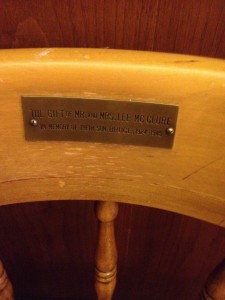
“The Gift of Mr. and Mrs. Lee McClure, in Memory of their Son, Bruce, 1924-1945.” Photo Taken by Melissa Mariotti
Each chair has a small plaque on them to commemorate him. Bruce came to Wesleyan in 1942 and was enlisted that following spring. He was a member of Phi Gamma Delta.
It is uncertain whether or not every item in the room was donated by the McClure family
There is a large plaque that is placed on the wall with the names of the students who fought and died in combat. The plaque is titled, “Illinois Wesleyan University Students Who Made the Supreme Sacrifice in World War Two.”
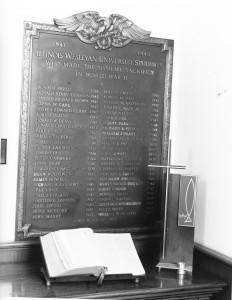
Plaque commemorating the students from IWU who gave their lives during WWII. Photo found in RG 18-1/17
Among those names is George Lansing Fox, whom the room is now dedicated to. There is small collage dedicated to him and “The Four Chaplains.” George L. Fox graduated from Illinois Wesleyan in 1932 and served in World War I, receiving many prestigious awards, such as the Silver Star, Purple Heart, the Croix de Guerre, and the Furaguerre. He enlisted in World War II as a chaplain and deployed on a ship called the USS Dorchester.
In 1943 the USS Dorchester was torpedoed by a German submarine. Fox was one of four chaplains on the ship. The others were Catholic, Protestant, and Jewish. After realizing that there were not enough life vests on the ship, the four chaplains gave up their own so others could survive. They were last seen kneeling on the deck of the ship in prayer as it sank.In 1951 president Truman dedicated a chapel at Temple University, Pennsylvania, The Chapel of the Four Chaplains, and made a commemorative postage stamp in their honor.
Research files: Tommy as a cartoon character
In this post, we have two views of the same object: a plaque in the archives that contains the first image of Tommy Titan as something other than a person in costume. This artifact contains the earliest record we have of the transition from Tommy as a person dressed in titan-esque attire (see details in previous post) and the costume-wearing student who serves as our mascot today!

